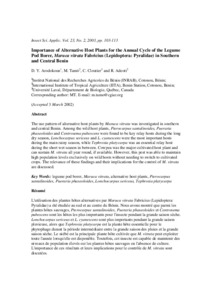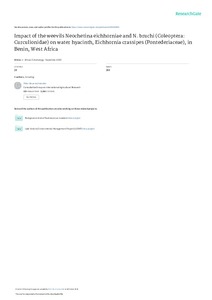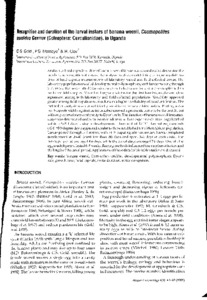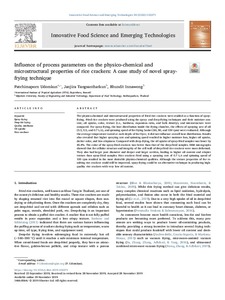Welcome to the International Institute of Tropical Agriculture Research Repository
Journal and Journal Articles: Recent submissions
Now showing items 1401-1420 of 5273
-
Importance of Alternative Host Plants for the Annual Cycle of the Legume Pod Borer, Maruca vitrata Fabricius (Lepidoptera: Pyralidae) in Southern and Central Benin
(2003-06)The use pattern of alternative host plants by Maruca vitrata was investigated in southern and central Benin. Among the wild host plants, Pterocarpus santalinoides, Pueraria phaseoloides and Centrosema pubescens were found to be key relay hosts during the long dry season, Lonchocarpus sericeus and L. cyanescens were the most important hosts during the main rainy season, while Tephrosia platycarpa was an essential relay host during the short wet season in between. Cowpea was the major cultivated ... -
Effect of detopping on disease incidence and symptom severity of African cassava mosaic virus disease (ACMD) on some newly developed cassava cultivars form landraces introgression
(2003)Twenty-five cassava genotypes were exposed to natural infection by African cassava mosaic disease (ACMD) in plots at the International Institute of Tropical Agriculture (IITA), Ibadan (forest-savanna transition zone), Nigeria. The effect of removing the shoot tips (detopping) of cassava plants on disease incidence and symptom severity was assessed fortnightly for 14 weeks, starting 8 weeks after planting (WAP). There were highly significant differences (P < 0.01) in disease incidence (DI) and ... -
Release, establishment, spread, and impact of the weevil Neohydronomus affinis (Coleoptera: Curculionidae) on water lettuce (Pistia stratiotes) in Benin, West Africa
(2003-09)The weevil Neohydronomus affinis Hustache (Coleoptera : Curculionidae) of Neotropical origin was imported into Benin in 1993 and released in 1995 for the biological control of water lettuce Pistia stratiotes L. (Araceae). After the release of N. affinis in water bodies linked to the Mono River system, southwestern Benin, larval mines characteristic of immature stages were observed in all seasons in the first year and the weevil was considered established. Two years later, it had spread 90 km from ... -
Influence of process parameters on the physico-chemical and microstructural properties of rice crackers: a case study of novel sprayfrying technique
(2020)The physico-chemical and microstructural properties of fried rice crackers were studied as a function of spray-frying. Fried rice crackers were produced using the spray- and deep-frying techniques and their moisture content, oil uptake, color, texture (i.e., hardness, expansion ratio, and bulk density), and microstructure were compared. For spray-frying, the heat distribution inside the frying chamber, the effects of spraying rate of oil (0.3, 0.5, and 0.7 L/s), and spinning speed of the frying ... -
Seed treatment with Trichoderma species for control of dampingoff of cowpea caused by Macrophomina phaseolina
(2001)Cowpea seeds treated with three Trichoderma spp. at four inoculum doses, and at four exposure times in three different formulations were planted in soils amended with Macrophomina phaseolin a, and assessed for stand establishment and post-emergence damping off. The highest percentage plant stands at 21 days after planting were 66% for T. koningii and T. harzianum , and 51% for Trichoderma sp., at 6.8 2 10 7 , 2.0 2 10 10 , and 1.0 2 10 7 colony forming units (CFUs) ml -1 , respectively. ... -
Effet de la p'eriode de pollinisation manuelle sur la fructification de l'igname (Dioscorea rotundata Poir; Dioscoreaceae) en Cote d'Ivoire: Effect of the manual pollination period on the fruiting of yams (Dioscorea rotundata Poir; Dioscoreaceae) in Ivory Coast
(2019)D. rotundata is the most popular species among consumers in Côte d'Ivoire. However, its production is stagnating due to the many constraints associated with its cultivation, particularly virus diseases. The use of improved varieties from sexual reproduction could effectively contribute to sustainable production. This work aimed to evaluate the crossing period in order to increase fruiting rates in this species. A total of 28 intra-specific crosses were carried out using 4 female and 7 male clones ... -
Plant parasitic nematodes associated with plantain (Musa spp. AAB-group) in southern Nigeria and their relative importance compared to other biotic constraints
(2001)The predominant nematode species found on plantain in southern Nigeria was Helicotylenchus multicinctus which occurred at all 68 sites sampled. Hoplolaimus pararobustus, Pratylenchus coffeae and Radopholus similis were found at 64, 50 and 46% of the sites, respectively, while Meloidogyne spp. second stage juveniles were found at 68% of the sites. Other nematode species occurred at less than 5% of the sites and included Helicotylenchus dihystera, P. zeae, P. brachyurus, Rotylenchulus reniformis, ...





